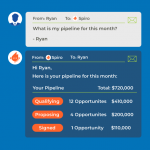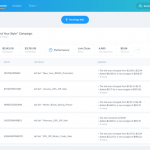Can AI Figure Out That You Secretly Suck At Your Job?
While you’re busy worrying whether a robot is going to take your job, some companies are building tools to better measure how well you do it.
Machine learning is already doing an increasing variety of work, from chatbots that answer customer-service questions and screen job candidates to systems that analyze employee data that an HR department would otherwise track across dozens of spreadsheets and emails. Now there’s a tool for examining human productivity–very, very closely.
Finding Weak Links
Called Nintex Hawkeye, the product was developed by parent company Nintex, a process automation platform that’s been around for a little more than a decade. But this new technology is giving employers a wider lens onto their staffers’ productivity. Hawkeye analyzes data on business processes by types, users, roles, and departments to see who’s doing the work and how long it takes them to do it. Management can monitor and analyze those metrics in real time.
“We facilitate getting work done,” says Ryan Duguid, Nintex’s SVP of technology strategy. Which sounds simple enough, but Duguid notes that measuring productivity can get “kind of squishy” all the same. Hawkeye starts working through the layers of data it rakes in from the top level down, examining who’s doing what across the organization and then parsing specific tasks through what Duguid calls a “process lens” for each of those functions.
Take on-boarding, for example. Machine learning sifts through every instance of a new hire being on-boarded to determine how long that process took on average, how long it took to get approval to hire a new person in the first place, and what the best sources of candidates are. But Hawkeye generates more granular information, too, which zeroes in on individual employees’ metrics: Who’s the most effective recruiter? What, if any, characteristics do new employees have that show success at 30-, 60-, and 90-day reviews?
What The Data Doesn’t Say
Where Hawkeye can really benefit companies, says Duguid, is by making connections between these various data points that managers might not spot. If one person is approving hires at the rate of once a week and another is taking two weeks, for instance, it may seem on the surface that the first employee is more productive. But through data analysis Hawkeye might discover that the swifter approvals have also led to speedier employee exits. Not only does the tool tell the company how much productivity is dropping as a result of having to refill those positions, it also identifies the causes and culprits.
Duguid admits there are also human reasons why someone might not be performing well. Maybe someone just came back from vacation and is backlogged, or maybe they’ve got just 20 other people to manage, versus someone who only oversees two. Hawkeye can’t necessarily determine the context in situations like these. It only alerts employees and managers to a drop in productivity so that they can discuss what might be going on.
“Where it starts to get interesting,” Duguid says, “is when you start to look across companies and industries”–in other words, the aggregated data for the same tasks Hawkeye has tracked across the roughly 7,000 businesses currently using the platform (anonymized, of course). Duguid does offer a caveat: “Take that for what it means; [other businesses] may be automating things you don’t care about.” Some tasks may be performed by humans in one company and handled by machines in another, so the data sets wouldn’t always be comparing the exact same examples.
Locating Targets For Automation
If some workers worry that tools like Nintex Hawkeye feel like Big Brother, ruthlessly examining their productivity for signs of weakness, there may be another risk, too. As the machine learns patterns and behaviors, it suggests which human-driven processes to automate, such as approving expenses on certain dates under certain amounts. You can see how those tasks may still take human oversight and regular check-ins–for now anyway.
Some processes lend themselves to easy automation; others don’t. But one logical first step for figuring out which tasks to automate is to measure how well humans actually do them. In the meantime, employees can take comfort that Hawkeye’s capabilities are currently limited to pattern-recognition on certain tasks and outcomes–not every single thing that happens in the space of a workday.
In Duguid’s view, the insights Hawkeye generates are intended to spark conversations between managers and their staffers about how to do things better. Through a dashboard, it even nudges users with messages and data visualizations, letting them know they could be doing their jobs better. But it’s easy to see how even this might rub some the wrong way. Duguid admits it’s tricky on ethical grounds when data exposes the so-called weakest links; whether identifying performance that’s below average or high above, “it’s important not to assume too much,” he cautions.
“Philosophically, our goal has always been to provide as much data as possible at that point in time to make the right decision most often, [and] in the right fashion in line with your corporate policy,” says Duguid. But Nintex’s technology is already aiming far beyond that. “We orchestrate human activity,” he says. The real goal is “how all of this work is helping a company do what it does best.”
Fast Company , Read Full Story
(37)














